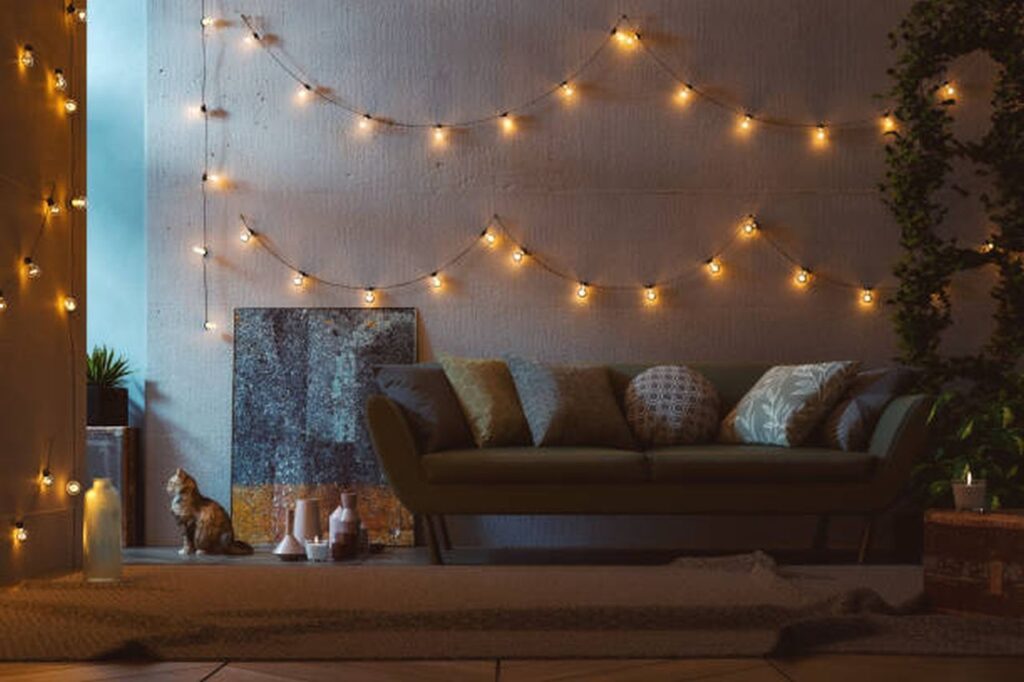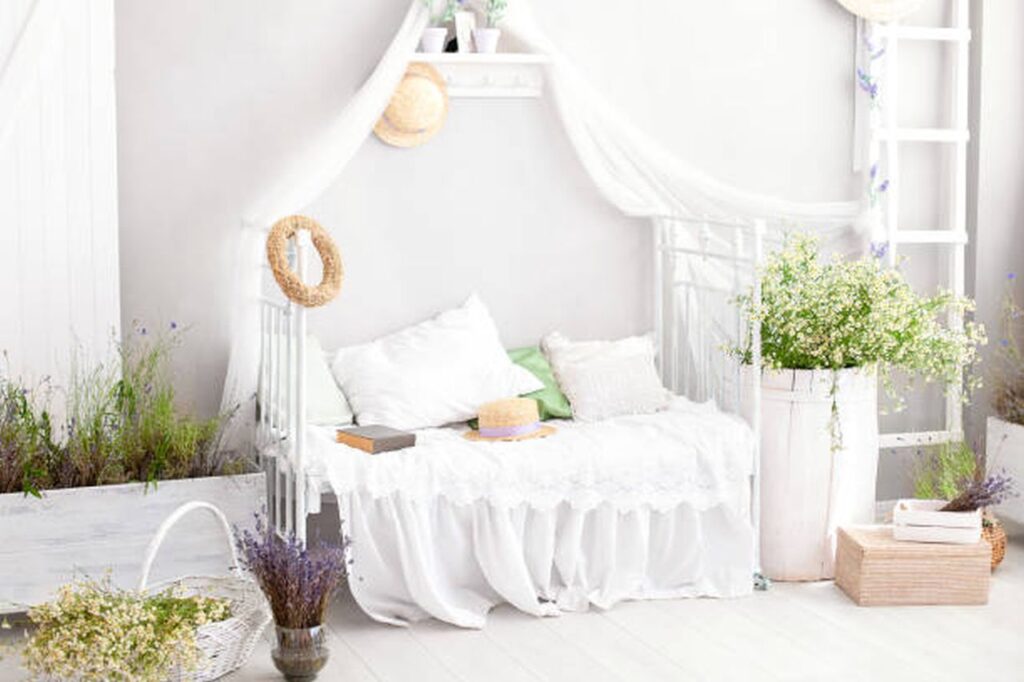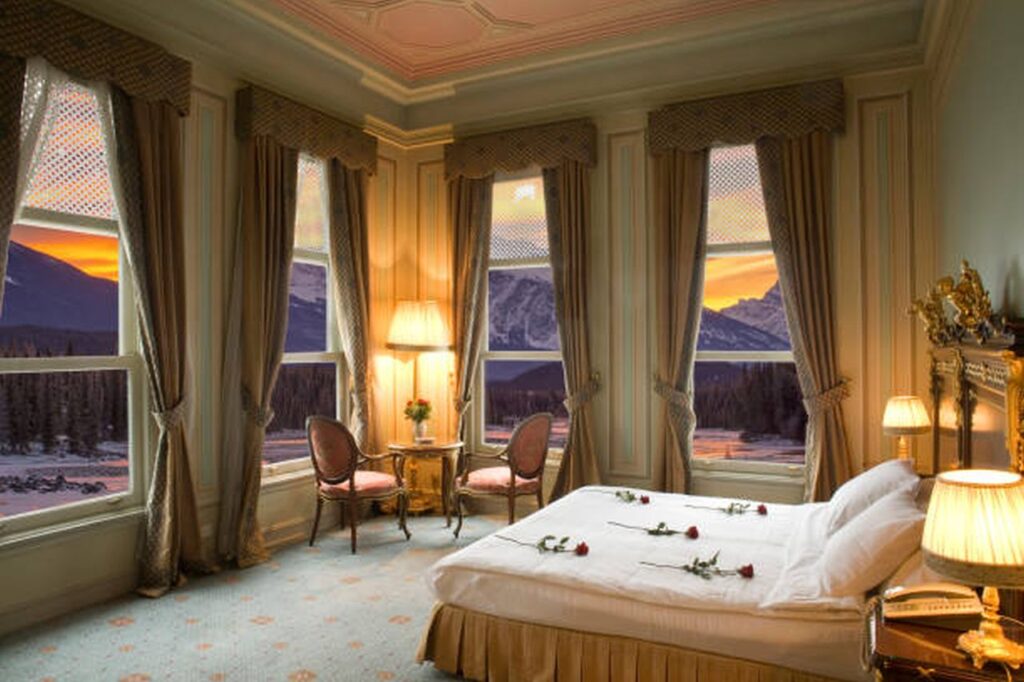Who doesn’t want a little more romance in their life? But, of course, we’re not just talking about a romantic relationship with a significant other—but rather that elusive touch of soft plastering elegance that comes with romantic home decor.
But what is a romantic style in terms of decor and design aesthetic? Below, we’ve broken down exactly what romantic style entails—and how you can emulate the subtle, feminine style in your own space. So whether you’re looking to add a touch of soft, vintage-inspired flair to your home or you want to create a romantic-inspired space to retreat to, this primer will help you set off on the right foot.
A Brief History Of Romantic Style
Although romantic style can date back to the Romantic Era in Europe at the end of the 18th century—think Louis XV and his court’s canopied beds and detailed floral wallpaper—how we think of the comfortable design today has much more to do with the revival of soft, feminine clothing design at the end of World War II.
“I think the best example in history of this style is the design icon Dorothy Draper,” shares Jennifer Burt, Home Staging Expert at Mississippi Maximalism. “After World War II, that lifted fabric restrictions in clothing and the exaggerated feminine shape was popularised by Christian Dior’s ‘New Look.'”
According to Burt, this ultra-feminine look flowed over into interiors, where Dorothy Draper redecorated the entire Greenbrier Resort in West Virginia, which is a perfect example of romantic style thanks to its “bold new personality, using colour and oversized patterns to paint a picture that reflected the luxury of space.”
What Is The Romantic Style In Interior Design?
Aside from evoking images of pink hearts and ambient mood lighting, the term romanticism refers to a particular style and aesthetic discipline in interior design.
Design during the Romantic era developed in the late 18th century is associated with bold florals, canopied beds, elaborate candelabras and a refined look. The modern version of Romantic design is more subdued, often utilising pale, neutral colours, soft curves and metallic details – however, florals remain a core feature of the trend.
If you want to add a hint of romance and whimsy to your space, you may want to incorporate some of these features, along with some of our favourite romance-inspired interior ideas below.
Romanticism in the interior is an elegant style. The interior is perfectly combined: forging, arched doorways, beautiful flowers in vases, sculpture, glass, flowers, light fabrics. Furniture upholstered in silk fabric, silk pillows. This style is all about setting the mood in your bedroom by filtering light through sheer curtains, using soft bedding and fragrant floral arrangements. In our projects, we use exclusive furniture from Italian Suppliers.
The interior in the style of romanticism is characterised by intimacy, balanced proportions, simple shapes and bright colours. The rooms were light and airy, making the interior moderately simple but psychologically comfortable. The room walls with deep window niches were stained in white or other light colours, papered Etched striped wallpaper. The upholstery was the same. These cloth interior details were coloured and contained drawings of flowers.
There is the concept of “clean room”, which is a room that is not used on weekdays. You used this normally closed “Sunday Room” only for the reception. Additional comfort residential interior painted in warm tones of the furniture design and wall watercolours, engravings, and a large number of jewellery and souvenirs.
As is the case with the stylistic preferences, practical Biedermeier takes only those items of furniture that fit its conception of functionality and comfort.
The main criteria of this style are furniture – durability, quality factor and convenience. The characteristic features of the Biedermeier furniture – gently curved backrest and armrests, armchairs, sofas, chairs, bent and machined table legs. Simplicity furniture forms compensated bright colours of upholstery and functional practicality furniture designs.
The home environment complements windows, bookcases, corner cupboards, dressing tables, fashion at the time, and little harpsichords (spinet). In addition, there were sets from wide sofas and beds, supplemented by tables and chairs. For the upholstery of the seats and backs of chairs instead adopted in the era of Empire, silk used a simple tissue, such as cotton with a floral pattern, or a plain or striped reps as a flooring element used horsehair.
Key Characteristics
Think of romantic style as a relatively comfortable decor aesthetic—it’s not exactly overly maximalist or bold. Still, it does align itself with floral patterns, lace and softer fabrics, and an overall sense of vintage or regency-inspired femininity.
“Romantic style is characterised by being feminine,” agrees Burt. “Curved lines, sometimes bold colours (think how red lips are considered romantic), accents of shiny gold and silver, and floral or nature-inspired prints are some of the key characteristics to emulate.”
Decorating Tips
Looking to add a touch of romantic style to your own space? The key is to lean into your whimsical side while remaining practical-minded and elegant. Consider pulling from inspirational photographs from the past decade—or Romantic Era painters like John Constable or J. M. W. Turner, which offers a sense of lightness and natural elements. Here are some practical tips to help get you started:
Go For Warm, Neutral Upholstery
“When customers are seeking furniture pieces with a romantic style, we often recommend warm, neutral stain and upholstery options,” explains Sebastian C., Founder of Countryside Amish Furniture, LLC. “Choosing warm tones softens the atmosphere and creates a relaxed mood in any design space.”

Consider Curved Lines
According to Founder, curved lines in furniture pieces represent the romantic style, and you may arrange pieces in an intimate grouping to create a comfortable mood. “Popular furniture designs include those with a vintage flair such as four-poster beds, wingback chairs, and china hutches,” he explains, adding that you can easily mix this style with other design eras like traditional, rustic, French country, or modern. “It only takes a few carefully chosen furniture staples and home accents to create a romantic space.”
Look To Fashion
Burt takes the style one step further in terms of its ease of use—if you have more of an eye for fashion than decor, it could work in your favour in this case. “To decorate with this look, just think of a romantic clothing outfit and recreate it,” she suggests. “A floral print always looks romantic as well as soft textures.”
Add Hints Of Metallic Shimmer
“Make sure to add in a metallic shimmer—this is like the jewellery of a room,” says Burt. “But most of all, keep the room simple. Romantic style can easily look cluttered, so I like to think of classic outfits and movies from the 1950s as inspiration.”
Pick Floral Prints
“Florals are a classic sign of romance,” says Amy Hillary, content creator at Wallsauce.com. “Choose floral wallpaper, bedding, and fresh florals in pretty vases.” Going for a regency core look or “Pride and Prejudice”-esque romanticism, it doesn’t take much more than a good floral print to achieve this ornate and feminine design.
Create The Perfect Mood Lighting
Many will think about creating mood lighting for their bedroom, but other rooms in the house can also benefit from ambient lighting that adds dimension and softness.
One of the best ways to add mood lighting into a room is to incorporate different light sources. It might include complementing one large statement light with smaller industrial wall lights or spotlights to create distinct areas in a room.
The style of light you choose can also contribute to the mood you create. Tinted glass lights will cast a subdued warm glow over your space for a cosy, intimate atmosphere. For a bolder feel, bright metallic shades can add a sense of drama and richness, enhancing the ambience even further.
Incorporate Romantic Red & Purple Into Your Interiors
Colour is another main factor that will impact the overall feel of an interior. And when it comes to capturing a sense of romance or Valentine’s Day charm, there is no better colour than red!
Initially, the boldness of red might seem difficult to work with. However, it is a colour that emits passion, drama and energy – perfect for making a fiery statement in a range of interiors.
The key to using red in your home is to temper its intensity with more subdued decor to avoid the space becoming too overpowering.
Bold purple colour schemes are also a cornerstone of the romantic look and can be just as vibrant an option as red.
Go For Pink In Your Interior Design
Of course, red isn’t the only colour that screams romance – there’s also pink to consider. Decorating with all manner of pinks, from a soothing pastel to vibrant magenta, is a great way to bring a sense of luxurious, chic style to your interior.
Adding pink accessories like cushions, blankets, rugs or artwork to your room is an easy way to incorporate a taste of this shade for a subtle, sophisticated look.
Rustic Nature-Inspired Interiors
Romance isn’t all about eye-catching red and pink – for some, a more minimal, pared-back look might be preferable.
An interior inspired by nature – whether this means using more natural materials, floral patterns or a neutral colour palette – can provide an airy, light quality to your space, creating somewhere that you can retreat and relax with friends and loved ones.
A rustic or cottage vibe exudes whimsy and a quiet sense of charm that taps into romanticism and regency-inspired interior trends.
Combine Different Textures
For a cosy, tactile space, combine contrasting textures. It creates an element of visual interest and makes your room more dynamic and inviting.
A combination of natural materials like warm woods, woven rugs, metal lights and soft textiles come together to make a picture-perfect interior designed for comfort and style.
Romantic Bedroom Interior Design Ideas
This idea of combining textures is especially relevant for bedroom design as it will help you create a personal sanctuary where you can relax at the end of the day surrounded by stylish serenity.
You could incorporate a textured headboard, different layers of blankets, cushions or drapes and soft shapes to offer a tactile treat for the senses.
Making a dedicated cosy corner in your bedroom – or any other spare spot in your home – can also help you embrace a sense of comfy intimacy while allowing you to stay true to your style preferences.
Pay Attention To The Finishing Touches
No interior would be complete without all the little personal details. It might include things like artwork or photography that reflects your style, along with vintage accessories that evoke a sense of romance from the past.
Houseplants can also make the perfect decor as they add life and vibrancy to a space – plants and greenery can even boost your mood!
Getting inspired by romance and Romantic styles is a great way to bring a sense of cosiness and luxury into your home.
If you want to show your interiors a bit of love with a design makeover, browse our range of stunning industrial and vintage lights to complete your space!

Romanticism As A Component Of Home Design
Many homes were built during the romantic era and were heavily influenced by the gorgeous castles of mediaeval Europe. Gothic revival, exotic designs, and Asian styles were all popular components of romanticism in architecture. Homes in the gothic revival style didn’t have towers most of the time, but they resembled gothic cathedrals from the 12th century in many other ways. Common designs included pointed windows, peaked roofs, and asymmetrical floor plans.
The term “exotic” was quite encompassing during the era of romanticism and meant any home that looked out of the ordinary. Sometimes, this meant Greek columns or Swiss chalets. But, most of the time, it meant Asian-inspired designs, especially near the end of the 18th century.
Interior Decor Of The Romantic Era
Louis XV’s love for Polish fashion and canopied beds ushered in the beginning of romanticism in interior design. Home furnishing styles were usually Chinoiserie, a European imitation of East Asian art and decor that often included flowers, plants, birds, and dragon designs. Although you could find the style throughout various rooms in a home, they were most popular in women’s dressing rooms and bedrooms.
By the late 18th century, romanticism combined with Neoclassicism to bring straight lines made of mahogany and brass to many interior rooms. Finally, the 1820s saw the Gothic Revival reach indoors as well. The furniture was individually crafted, so each was 100% unique and often very heavy.
Romanticism In Today’s Interior Design
Perhaps the reason the era of romance has continued to be a stronghold in the interior design world is because of its distinct ability to combine with several other styles. Traditionally, romanticism is seen alongside Victorian, English, and French designs, but it also pairs well with Tuscan, rustic, and country cottage themes.
The key is to incorporate the right elements. Start with a neutral colour palette of soft earth tones or light pastels to soften the room. Popular options include white or cream, shades of light purple, and dusty pink. True red also works well in romantic rooms if you prefer something bolder.
Aim for classic pieces of furniture. Plush, upholstered armchairs, sofas, and beds add comfort to the room. Create interest by including vintage dressers, desks, or tables. Romanticism is about softness, so seek out pieces with curved edges and group it around the room. For example, place a vintage bench at the end of your bed. Across the room, add a soft armchair and a side table to a reading nook.
A romantic interior design usually leans toward the feminine side with fabrics like lace and chiffon or those that have ruffles or floral designs. However, you can add more masculine decor to the room in small doses to keep it balanced in shared bedrooms or main living spaces. Satin, velvet, and wool are also popular choices.
Remember the little details as well. Extra-long curtains create a willowy, breezy mood, while silver mirrors and lamps add shine. Chandeliers and lamps should have low-wattage bulbs or dimmer switches. Large antique rugs add interest while providing comfort in any room, and finally, you can add life to the space with fresh flowers or even a bowl of your favourite fruit.
Whether you love history and have taken an interest in literary and design trends through the ages, or you want to add a soft touch to your bedroom or living room, it’s easy to see why the comfort of romanticism has remained a mainstay in the interior design industry. Professionals at Nazmiyal can help you find the right pieces for every room in your home the next time you redecorate.
While this blog discusses romantic interior decor as it relates to the art and ideas of the romanticism movement, this post may be inspiring you to think about romantic love. If that is the case, you’ll want to check out some of our pop art “Love” rugs by artist Robert Indiana!
Conclusion
So, what is romantic interior design? It’s a style that celebrates love and affection in all forms. Everything about this type of design shouts ” romance, ” from hearts and flowers to velvet textures and rich colours; everything about this type of design shouts “romance!” So, start with these tips if you want to create a space that feels like an intimate oasis for you and your loved ones. And always remember: there is no wrong way to do romantic interior design – as long as it makes you happy, that’s all that matters.
FAQs
What Is A Romantic Style In Decorating?
Romantic is a comfortable style that appeals to the senses through soft fabrics, floral patterns, lace, painted furniture, a pastel colour palette, light filtered through sheer curtains and aromatic flower arrangements.
What Is Romanticism Architecture?
Romanticism expressed itself in architecture primarily through imitations of older architectural styles and eccentric buildings known as “follies.” For example, mediaeval Gothic architecture appealed to the Romantic imagination in England and Germany, and this renewed interest led to the Gothic Revival.
Why Did The Romantic Era Start?
Romanticism in the 19th-century movement that developed in Europe in response to the Industrial Revolution and the disillusionment of the Enlightenment values of reason. Romanticism emerged after 1789, the French Revolution that caused a relevant social change in Europe.
What Is The Rule Of 3 In Design?
The rule of three says that things arranged in odd numbers are more appealing, memorable, and effective than even-numbered groupings.
What Is The Rule Of 1 Interior Design?
One rule that I feel is often forgotten, but is very crucial, includes using a small pattern in a small space,” says interior designer Jess Cooney. “Contrary to popular belief, this doesn’t make the space feel bigger — it does the opposite!

